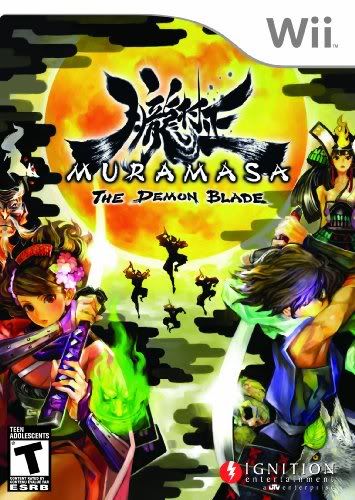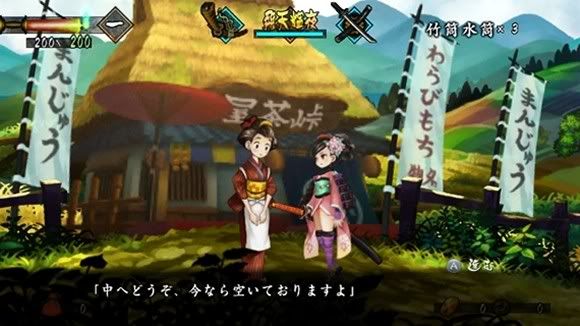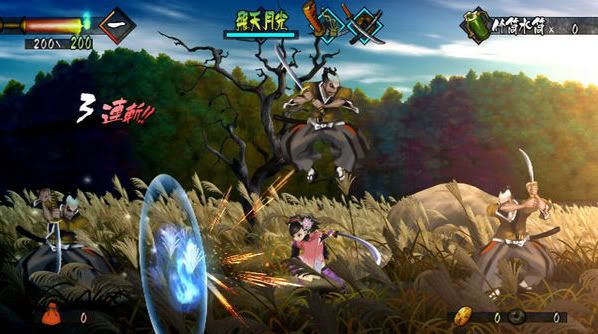I've never been that much for the "video games as art" argument. Beside games like Shadow of the Colossus and Okami which definitely took my breath away with their unique and attractive imagery, I've always thought of a game as being a form of entertainment and nothing more. Muramasa: The Demon Blade is a work of art and a fine one at that. If it were possible, you could hang up a screen in an art gallery, allow people to play Muramasa and it would blow their minds.

Everything in Muramasa: The Demon Blade looks crisp and extremely detailed
Muramasa: The Demon Blade features two playable characters: Kisuke, a young male Ninja being chased for crimes he cannot remember committing and Momohime, a princess of Narukami Han who runs away from her castle and becomes possessed by a foul swordsman named Jinkuro. While both characters don't have a large amount of variation in fighting style besides aesthetic details, their stories run in different directions. Kisuke heads from western Edo to western Kyo, while Momohime heads from western Kyo to western Edo. They both encounter different situations and both have their own unique eight bosses to encounter.
As I mentioned beforehand, Muramasa: The Demon Blade is a beautiful game. It's a side-scrolling fighting game with unique 2D hand-drawn, interesting and detailed graphics. Characters look very pretty and enemies are inspired by Japanese legends. There are a good variety of enemies but you do find they tend to be recolours. Not as though that is a problem when they look so great anyway. The music is of a true traditional Japanese style and the sound effects and voices are excellent and top-notch. Fortunately, the game has kept Japanese voices so the experience feels very authentic.
Everything in this game appears to have been hand-drawn
It isn't all action though. What makes Muramasa so deep and enthralling are the RPG elements in it. Your characters level up the more you fight enemies and they each have their own set of stats. Along with character stats, you also find items to heal yourself and accessories to equip. You can buy items from merchants along the road too. If you can't beat a boss, you can go back and train up just as you would in an RPG. It's a nice touch like that which sets it apart from other frustrating "old school"-style side-scrollers.
That isn't to say that Muramasa: The Demon Blade isn't completely easy. You have two modes of difficulty to choose from at the start: (with a third being unlocked after you finish the game) Muso, and Shura. Muso is purely for the story and is the games "Easy Mode" and delivers a lot less action-orientated experience and focusses more on building your character up. Shura is effectively "Hard Mode," where you'll need to dodge, roll and be efficient in combos, as this mode is far more action-orientated. While Muso is definitely the easier mode, Shura stays much more true to those who have a taste for tough side-scrolling games, with bosses being as tough as nails.
Sometimes you'll be able to chat to merchants on the road
The key feature to Muramasa: The Demon Blade are of course, the blades themselves. There are eight primary swords in the game, with one sword being unlocked per boss defeated. Those swords are special because they unlock specific coloured gates to either progress the story or unlock special areas. What is impressive is that there are 100 different blades to forge from a tree. Basically, you can "buy" weapons from the Forge (from the pause menu) but only if you have the prior weapon on the tree and enough Souls. To equip a weapon you must also have the right stats, hence the inspiration to level up. Swords have their own different stats and a different Secret Art, a powerful move that has limited use and must recharge. Secret Arts look great and can vary from using simple elemental attacks such as fire and electricity or spinning around like a whirlwind, hitting multiple enemies in a flurry. Swords come in two forms, Long Blades and Blades. Blades are small, short ranged and very fast. Long Blades are slower, larger and hit more enemies. You can have three swords equipped at one time. Swords can break, using Secret Arts or blocking too often depletes the Soul Gauge, however they do regenerate over time when not being used.
One problem I found with Muramasa: The Demon Blade was the emptiness and similarity of the locations you travel through. The problem is that once you enter an area, it all looks the same for awhile. You run from one side of a level to another, sometimes being given the option to go down a different path, but I went through a city and it almost felt like my character was running on a treadmill with the scenery looping in the background. The entrances and exits between areas may vary, sometimes the exit can be high up but platforming is extremely simple and you will never find it difficult to traverse the simple locations you travel through. You can go into certain buildings and fight enemies or find items which is nice, but the actual locations themselves can feel a bit empty. Everything looks beautiful though: The art-style is fantastic to look at. Whether you're running through a field of tall grass, a city at night, or down a dirt road with rice-fields in the distance, it looks great. Regardless of how similar everything looks, you won't get sick of looking at it.
Combos look nice, you can even deflect projectiles with your weapon
Enemies don't casually roam locations either. Muramasa takes a page from the RPG genre where baddies show up out of nowhere in random-battle-style. When you win you even get a box pop up showing how well you did, how much money you obtained, etc. It actually works quite well, it keeps the battles simple but because they show up out of nowhere, it just means that you can't swing your sword unless you're in a battle. The lack of enemies in real time mean that locations are a bit of a blank canvas until said enemies appear. The main problem with combat is that it is a bit simple. Don't get me wrong, it's not boring, but the combat consists of only two buttons: The attack button and the Secret Arts button. You'll be dashing around and dodging a lot, it all looks extremely fancy but don't expect a deep combat system. The closest thing to variation in fighting style are the two sword types.
Those points aside, it doesn't detract from just how much of a fantastic experience Muramasa: The Demon Blade is to play. After playing through it once I see no reason to play it through again and again to improve your characters, unlock every sword, discover bonus challenge areas and immerse yourself in the beauty of the Japanese scenery and artwork. If you have an urge to play a good arcade-style game with a hint of RPG, then this game is for you. If you were on the fence about video games as art then try out Muramasa: The Demon Blade, I can assure you that you will be impressed.
Neoseeker Muramasa: The Demon Blade user-review






How long did it take you to finish it? Think renting it for a few days could get my fill of this game? No multiplayer was mentioned, but do the games stunning visuals more than make up for it and make it a must-buy? Just wondering. :)
ReplyDeleteGreat review again. =D
It really depends.
ReplyDeleteIt's rare enough that it warrants a purchase to just sit on your shelf if you're a collector, but with lack of co-op or any multiplayer the only reason to play it again and again is to bask in it's undeniable prettiness.
As for how long it takes, it depends on the difficulty. Shura is tough as nails and it would stretch the game out just for the intense boss fights. You can swap between difficulties at any time too.
It's about 15 hours of gameplay overall, so a rent for a weekend and you'd have the story done. There's more to do as I said like enemy lairs, which are effectively challenge rooms: eg fight X amount of enemies, etc. Tons of swords to forge and there are quite a few attacks to learn too. ^^
If anything rent it and then see whether you'd want to hang onto it after you've completed it. I collect games myself, and Muramasa won't be around forever, that's for sure. ^^